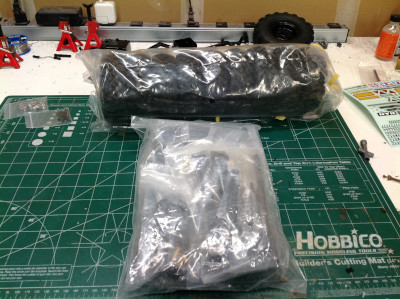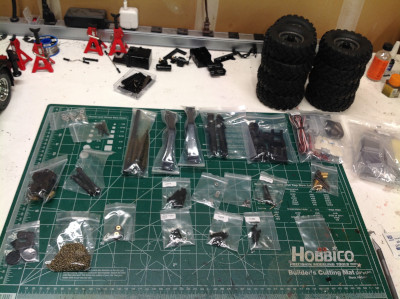Cross RC BC8 Project
Page 4: Building the Trailer
It is hard to describe the size of the box that this trailer came in or
the surprisingly large number of parts inside. There are 10 wheels
are tires (8 trailer and 2 spares) and a load of other bits, pieces,
and hardware. Nearly all of the parts are metal other than the
main trailer deck. The trailer kit includes wires and motors for
the rear ramp lift system.
Although the trailer comes as a kit, the main trailer deck comes
pre-assembled. The manual includes instructions for assembling and
gluing all the plastic parts, but you would need a significant amount
of tooling and jigs to assemble it flat without warpage. I usually
like to do my own assembly, but I was glad to see this portion was done
in advance. What you see on the left is this trailer deck sitting
atop the massive shipping box after I've applied the first layer of
primer and olive drab paint. The trailer is almost 5 feet long
even without extending the ramps. There is a lot of detail here
including centering rails, tie downs, wheel chocks, skid plates, and of
course the giant gooseneck.
The functional landing gear consists of a pair of metal spring loaded
cartridges with support links and large pads. When extended they
lock into place and support the trailer with the kingpin at the correct
height for connecting to the trailer fifth wheel. Depression of
the gray button on the side causes the spring the retract the strut
inner cylinder and raise the pad for towing. Note that there is
not much ground clearance for the bad so it will drag and turn into an
anchor in long grass.
This trailer has some serious rolling stock. The rear of the
trailer is supported by a pair of 4 wheel walking beams. Each
wheel is a metal beadlock with a scale center hub and spins
independently on a steel axle. There are scale air brake canisters
at each end of the walking beam.
Here the suspension has been attached to the frame. This is an
unsprung suspension which can support extreme loads. Each walking
beam is pinned to a frame rail and can pivot fore and aft. If you
are looking closely at the tire tread you'll see that I installed one of
these backward but I fixed it later.
The neck of the trailer includes a T-bar with pulleys on it which I
assume is intended to be used in conjunction with the truck's winch to
pull loads onto the trailer. There are also two different sized
spare tires here. The smaller tire is for the trailer and the
larger tire for the tractor.
The rear ramp lift system consists of a pair of small motor with
attached gear reduction units wired through a small electronic
controller. The controller is powered directly from a servo wire
routed all the way forward to the tractor's receiver via the longest
extension I've ever seen. There is a sleeve over the controller
but it is not potted so I'm not sure that it is waterproof. As
seen on the right, the motors are
tucked into the fixed portion of the rear ramps and the controller is
hidden between beneath a cross member.
The motor uses a pulley and a toothed belt to connect to the ramp.
The gearing is low enough that the weight of the ramp will not
backdrive the motor. In my opinion the speed of the ramp is way
too fast for scale, but there is no simple way to increase the gear
ratio. I'm not sure what the total is, but there are 7 stages of
reduction in the GRU. Assuming that each set is at least 2:1, the
overall ratio is at least 2^7 = 128:1. The final trailer is pictured at right just barely fitting on my build table.
©2019 Eric Albrecht

